![]()
![]()
©
2000 The Independent Fact Group
Recovery damage to the visor
(An excerpt from the full report)
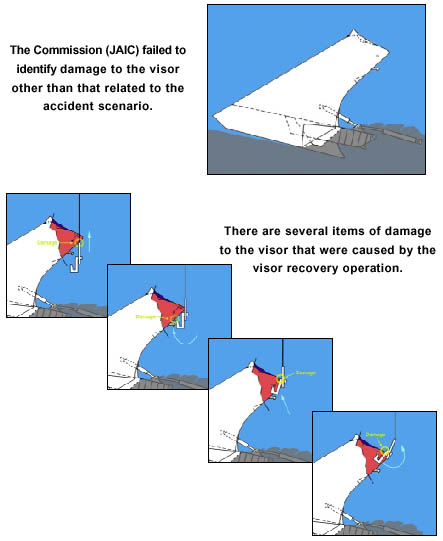
STATEMENT REPORT
| Subject: | Recovery damage to the visor |
| Type: | Statement |
| By: | The Independent Fact Group |
| Status: | Proved |
| Date: | 2000-05-01 |
| Version: | Report excerpt - English |
The Fact Group's aims and objectives:
The Independent Fact Group was formed in early 1999 to clear up the many question marks about the MS Estonia disaster, in a structured and methodical manner. There has been considerable speculation concerning the efforts of the Joint Accident Investigation Commission (JAIC) and the political, legal and media treatment of the accident and its tragic consequences.
The aim is to give those in authority an opportunity, based on the facts of the case, to decide to review this matter, with a view to further action. Our efforts also enable the media and the general public to decide on the basis of the objective information which is available concerning the accident, and the conclusions to be drawn from a technical and civic perspective.
The overall objective is the setting up of a new investigation of the accident which can describe the course of the accident in detail, and its causes, with subsequent assessment of the moral and legal responsibilities, where this is feasible.
We are motivated by the belief that a properly conducted investigation will contribute to maritime safety and by our concern for Sweden's reputation as a nation which upholds safety at sea and the rule of law.
Methodology:
In the course of this task, we have assumed that the solution of a problem is never better than the validity of the basic assumptions. As a result, we have stipulated some methodological principles, of which the following are the most fundamental:
1.All scenarios must be considered to be true until the contrary
is proved.
2.All observations, assumptions or statements on which a scenario
is based must be considered false until the contrary is proved.
We have defined a number of criteria for concluding that an observation, assumption or statement may be considered to be true or false, and processes and routines for the route to be taken in clarifying an observation, assumption or statement. These criteria involve technical, empirical, statistical and/or semantic requirements which, if they are relevant must all be met if the observation, assumption or statement is to be classified as an objective fact.
The materials we have worked with are primarily the documents, audio recordings and films in the Swedish Accident Investigation Commission's Estonia archive, together with supplementary information from other public sources and, in addition documentation from the Meyer shipyard and its independent commission.
| Table of Contents * |
Page |
| Summary |
3 |
| The visor - "as found position" |
4 |
| General description of the recovery method |
6 |
| The recovery operation, "HMS Furusund" report |
8 |
| Summary of the recovery operation - relationship between time and action |
9 |
| Redesign of the yoke, reconstructed by the Fact Group, and damage to the yoke between the various attempts to recover the visor. |
10 |
| The recovery of the visor |
12 |
| The yoke after the recovery of the visor |
14 |
| The visor bottom - status BEFORE recovery - damage |
15 |
| The visor bottom - status AFTER recovery - damage |
16 |
| The JAIC conclusions regarding damage to the visor |
18 |
| Possible explanation of the damage caused during the recovery |
20 |
| The Fact Groups conclusions |
22 |
| Sources |
23 |
| Dedication |
24 |
* Highlighted bold contents in this excerpt.
Summary (page 3)
In this report, the Independent Fact Group shows that damage
to the visor was caused by the visor recovery operations, and
that the JAIC failed or did not care to identify damage related
to the recovery.
As a consequence, the damage to the visor has been consistently identified as caused by the "loss of the visor", and was identified by JAIC as directly related to the sinking of the MV Estonia.
The Independent Fact Group shows that it is probable that a considerable propotion of the damages previously found to be a result of the loss of the visor, was instead the result of the recovery operation.
However the Independent Fact Group does not draw any conclusions in this report make related to damage to the visor, other than damage proven by this report to be caused by the recovery operation.
We leave it to a coming new independent investigation group to draw the correct conclusion as to which damage was caused by the accident, and which damage was caused by the visor recovery operation, and of course how this would influence the reconstruction of the sinking scenario.
To summarise this report in a few sentences: The JAIC has failed to identify damage to the visor other than that related to the accident scenario. There are several items of damage to the visor that were caused by the visor recovery operation. It must therefore be concluded that it is impossible to describe the sinking scenario as due to damage to the visor, before this damage has been correctly identified.
Definitions of certain language marks used in this report:
Text presented from the JAIC final report and its supplements is quoted as printed.
Our comments, explanations or clarifications, within quotes, are presented within square brackets [ ].
Text in quotes that has no relevance for the issue at hand has been left out and is indicated by a number of dots ".....".
We have underlined certain sentences and words, to mark their importance.
The visor - "as found position" (page 4)
The visor was officially found on 18 October 1994 at the position 5923,0' N 2139,2' E about one nautical mile west of the wreck. It was confirmed by ROV video-recordings. The Commission decided that the bow visor should be recovered and brought ashore for a detailed survey.
The recovery was carried out on 12 - 19 November 1994. The Swedish Navy mine-sweeper FURUSUND and the Finnish Maritime Administration icebreaker NORDICA participated in the work. The bow visor was recovered on 18 November. It was taken ashore in Hanko, Finland.
From a video recorded by the Finish authorities on 18 October 1994 (Finnish archive "visiri 17-18/10 -94") the visor positioncan be seen on the bottom of the Baltic. The visor was standing upside down with all of its gunwale (i.e the upper part) free from the seabed. The only parts of the visor that had sunk into the mud were the visor arms and the housing for the ramp. See the picture below.
In a telefax 26/10 1994 from Kari Lehtola (Finnish Accident Investigation Board) to Olof Forssberg (Swedish Accident Investigation Board) there is an enclosure, "A preliminary summary of observations on the bow visor video" (SHK archive Estonia I 33). The visor position was confirmed as "The bow visor lies on the seabed upside down. The visor arms are buried in clay and cannot be seen. A large part of the visor operating cylinder on the right side (starboard side) is also under the clay."
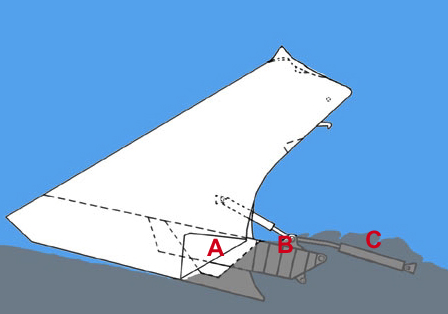
Picture 1. The picture shows the visor seen from the starboard side, standing upside down resting on the visor housing (A) with the visor arms (B) and the starboard hydraulic actuator (C) covered with mud. On the video (visiri) it can be seen that the rest of the visor was standing free from the bottom and that there were no contact marks on the bottom around the front of the visor.
General description of the recovery method (page 6)
It was obviously decided that the recovery should be performed by construction of a special yoke with four hooks. It was to be attached to the visor construction near its bottom. The yoke was made from a 100 mm thick steel plate, 4 metres wide and 2 metres high. According to a diver who participated in the recovery operation, the weight was 12 tons. The calculated weight was less, around 8 - 9 tons. The first design of the yoke (that we have found) is shown in picture 3 below. The yoke was marked with the letters G and R on one side, and G, X and R on the other side, and the edge of the yoke was painted white to be visual to the ROV cameras under water. Four hooks were attached to the yoke.
The recovery plan was to lower the yoke in the sea down to the visor and then "catch" the visor with the hooks. The operation was to be monitored by a ROV (Sjöugglan) and the control of the ROV was manned on the HMS Furusund. The theory of the "catch" is described in picture 5 on the next page. It can also be compared with picture 6 which shows the yoke hooked to the visor after the visor was recovered to the surface.
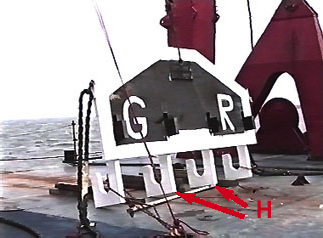
Picture 3. The picture shows the yoke hanging from the aft crane on the MSV Nordica. The four hooks can be seen hanging from the yoke (H).
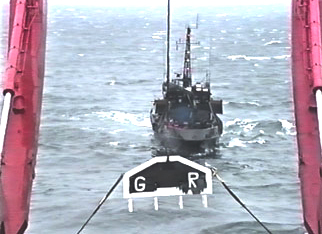
Picture 4. The picture shows the yoke hanging over the water at the first attempt to recover the visor. In the background, HMS Furusund.
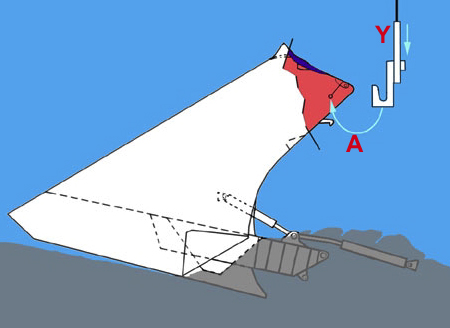
Picture 5. The yoke (Y) lowered to hook into the visor, arrow (A).
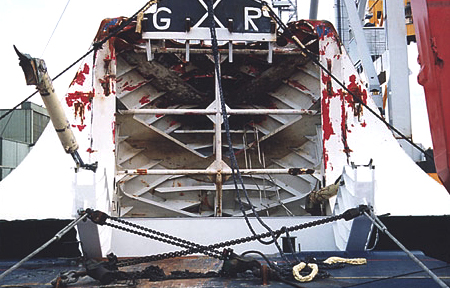
Picture 6. The yoke (marked G X R) hooked into the visor after recovery.
The visor bottom - status BEFORE recovery - damage (page 15)
The damage to the visor was videofilmed before the visor was recovered. The video shows that at least 5 damaged items "were missing" in relation to the damage found after recovery. This can clearly be seen when comparing the videos before and after the recovery. The location of the "missing damaged items" can be seen in pictures 20, 21 and 22 and compared with the same areas shown below.
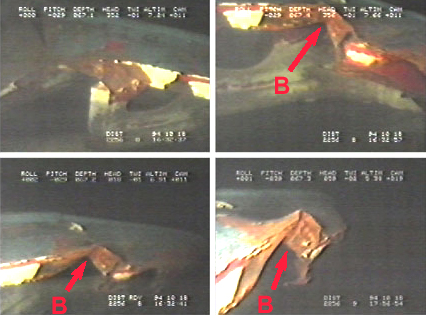
Picture 17 from "visiri" 94.10.18 at around 16.32. The beam (B) on the port side of the visor bottom was not completely broken before the recovery, but damaged. Compare with pictures 22 and 23.
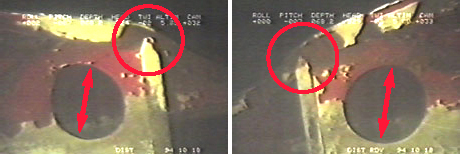
Pictures 18 and 19 from "visiri" 94.10.18 at around 17.57. The two round holes (arrows) on both the starboard and port side were not damaged before the recovery. Compare with the damage after the recovery, pictures 21 and 22. Also compare the connection between the vertical and transverse beam within the red circles with the same area in pictures 21 and 22. This clearly shows that the bottom of the visor was bent further forward as a result of the recovery operation, resulting in separation between the horizontal and vertical beam.
The visor bottom - status AFTER recovery - damage (page 16)
After the visor was recovered, it was found to be extremely damaged. The bottom plate itself was "pushed up" and the aft part of the same plate was bent up. Other damage seemed to have been "pushed down" indicating damage in both a downward and upward direction. The Commission did not, however, identify the damages caused by the recovery operation. Five items of the damage are identified below.
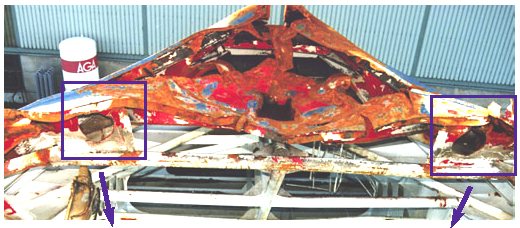
Picture 20. Overview of the bottom plate damage and details below.
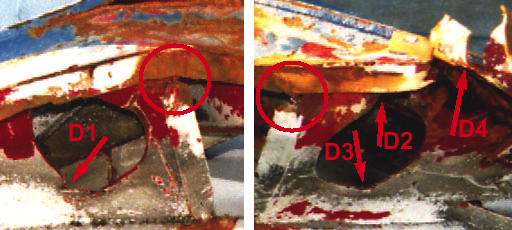
| Picture 21. The round hole is damaged (D1) in an aft direction. The outer starboard hook on the yoke has broken the plate with the hole when twisting around the transverse beam. | Picture 22. The round hole is damaged (D2) in an forward direction. The outer port hook on the yoke has broken the plate with the hole when twisting around the transverse tube beam. It has also created buckling (D3). The yoke also broke the beam (D4) as can also be seen in picture 23. |
In the picture below, it can be seen that the transverse beam (B) has been ripped apart in an upward direction (D4) in the picture.
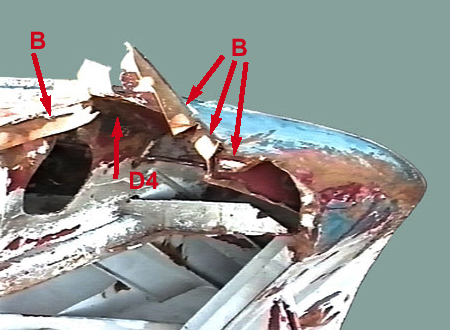
Picture 23. The port bottom side of the visor after the recovery.
The Fact Groups conclusions
The video films taken before and after the recovery of the visor show that the visor suffered further damage during the recovery.
The Commission has not indicated by a single word that it even suspected that damage might have occured during the recovery. Furthermore, the Commission did not describe the recovery operation, and therefore it must have been presumed that the recovery did not affect the visor in any way. Obviously, all the damage to the visor have been regarded as a result of the accident.
The Commission concluded that the various items of damage to the visor indicated that:
the visor hit the forepeak deck while loose but still rotating around the visor hinges,
the visor was moving up and down 1.4 metres along the front bulkhead during the loss of the visor,
score marks were the result of those occurences.
This damage has provided substantial evidence for the accident scenario described by the Commission.
As some of the damage has now been proved to be the result of the recovery operation, the complete scenario in accordance with the JAIC's conclusions must be regarded as unconfirmed.
Therefore, it is clear that a new investigation must take place.
DEDICATION
We dedicate this report to all those who lost their lives at sea as a result of a ships lack of seaworthiness.
If MV Estonia had been seaworthy many of the more than 850 persons who lost their lives would have had a chance to survive.
Stockholm 1 May 2000